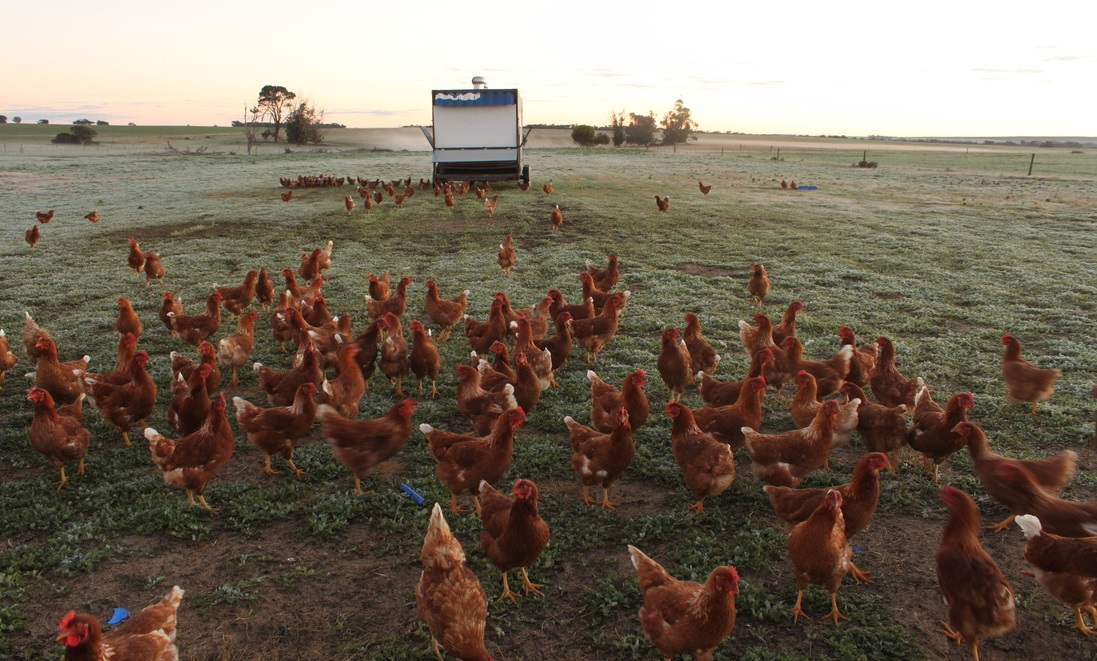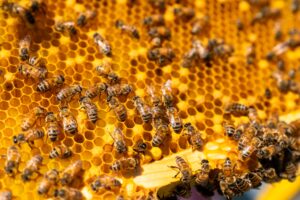Scrambled, fried, sunny-side up, in quiche, a stir-fry or even a cake, Australians love their eggs.
Every day, 90% of all Australians consume more than 15 million eggs—that’s about 5.5 billion eggs a year or about 230 eggs per person each year.
Our taste for eggs has been steadily growing, but not just for any eggs. Australians are increasingly preferring free-range eggs over the traditional caged egg-farming system. But with around half of the eggs produced in WA coming from caged hens and the rest of the world changing their caged eggs standards, it’s time we reassessed our practices.
The poultry welfare standards are open for public comment until 26 February, so what are the Australian standards for caged, barn and free-range eggs and do these practices effect egg quality?
Life in a cage
According to RSPCA, there are about 9 million caged hens in Australia, which provide us with eggs for our hungry tummies. According to Australian Eggs, a not-for-profit company that provides various services to Australian egg farmers, eggs coming from caged hens are just as good as any other egg—in fact, they can be even better.
“There are pros and cons to each of the three egg-farming systems. Farmers use cages because they have the lowest biosecurity risk, lowest incidence of disease and lowest antibiotic use. Free-range hens have the freedom to exhibit natural behaviours, but the outside environment can expose them to outdoor pathogens meaning they sometimes get sick and require antibiotics.”
They are also somewhat cheaper, so they represent an affordable source of protein for low-income families.
But have you ever wondered what is it like for a caged hen? For starters, they stay their whole life (about 18 months) inside a cage. They never see sunlight, as the cages are confined to large sheds with artificial lighting. And forget about socialising with other chickens or doing anything else other than eating and laying eggs.
“Battery cages (also known as conventional cages) are barren wire cages that house 4 to 6 hens, with each bird having around the space of an A4 piece of paper to live in for her entire life. As a result, hens in battery cages experience extreme confinement and behavioural restriction, without even enough room to stretch their wings,” according to RSPCA Australia.
“Due to the inability to walk, flap their wings or perch, hens in battery cages suffer very poor muscle and bone strength, a high rate of bone fractures, frustration, abnormal behaviours and poor welfare. The ability to perform natural behaviours is important to good welfare in poultry.”
Chicks hatch in artificial chambers and never see their mother. Female chickens never get to care for their chicks, and male chicks, well, they get the worst end of the deal. Because males don’t lay eggs or aren’t suitable for meat, whenever a chick is determined to be male, it is automatically disposed of—a process called chick culling. This can be done by carbon dioxide gassing or by being dropped into a grinding machine, alive.
The procedure is approved by the current standards, as described in this RSPCA release, and is actually considered humane. “Quick maceration ensures the chick is killed within a second and, if carried out effectively and competently, this method may be considered more humane than gassing with high concentrations of carbon dioxide,” says RSPCA.
There are alternative, more humane methods being studied, like a technique being developed by CSIRO to identify male chicks well before they hatch.
Shortly after birth, female chicks can have the tip of their beaks cut off to avoid getting themselves or other chickens hurt during their stressful months in the cage. This is no hype—again, it is all part of the official standards.
During their lifetime, chickens can be deprived of food and water for up to 24 hours—a process called forced moulting, which helps promote egg laying. Eventually, at around 18 months of age, egg production slows down and chickens are sent to the slaughterhouse. That’s it. Life in a caged farm.
Life in a barn
Eggs labelled barn eggs come from chickens that are not confined to a cage—just to a shed. Life is a bit better for these chickens, but still, they are not quite free.
Chickens in barns live in quite crowded facilities, with as many as 10,000 birds in each shed. But according to RSPCA, barn-laid eggs are a good alternative to caged eggs. “A well-managed barn can be just as welfare friendly for a hen as a proper free-range facility,” says the RSPCA website. It all depends on how you manage your barn.
Despite this encouraging statement, depending on how the barn is managed, living in crowded corners could mean that chickens cannot engage in natural behaviours, like dustbathing, grazing, nesting or perching. “Customers need to look for independent certification, such as RSPCA Approved, so that they know their eggs have come from hens raised to standards that encourage hens to express behaviours such as dustbathing, perching and socialising,” says RSPCA.

A free-range egg
Not all free-range systems are the same. Free-range farms can vary between 10,000 chooks per hectare to just 5! Current regulations require free-range egg packaging to advertise the facility’s stock density—how many chickens per hectare it carries—but you still find some free-range eggs without this information.
A good example of a good free-range egg facility with a very decent stock density is Manavi Farm, which stocks 50 hens per hectare and rotates its hens for optimal feeding—you can find the eggs in local supermarkets in Perth. Alternatively, you could go for a brand that lets you peek at the chickens in real time. Like the eggs from Sunny Queen Farms, which has live broadcasting of its hens. A few other brands follow this approach.

If you are concerned about how crowded the living arrangements of egg-laying hens are, check out this table before you buy or download the app—the consumer advocate group CHOICE has created an egg-finding app CluckAR that tells you just how free-range your eggs really are.
So which is the best egg to eat?
Research is clear on one thing—the nutritional quality of an egg is a complex matter. While there are different factors involved, a key to a more or less nutritious egg is in the food chickens eat.
“Today, there are some hens that are now raised on stored feeds that are high in omega 3 (such as flaxseed) or with vitamin supplementation or other feeds that are high in vitamins. In such cases, these hens may be caged but can also produce eggs that are elevated in omega-3 fat or the supplemented vitamins,” says Heather Karsten, Associate Professor at Pennsylvania State University.
But some studies found that free-range chickens can make better eggs, and organic eggs are less likely to carry dangerous pollutants, as one study found in some free-range Chinese chickens. But don’t be fooled into thinking that just because an egg is free-range it is better. It all depends on how free-range the chickens really are.
“Free-range means nothing if hens are not going outside—hens must be provided with unimpeded access to an attractive range area with plenty of overhead cover and vertical structures to provide shade and protection from aerial predators. The quality of the outdoor area affects access—for example, providing areas of palatable vegetation, trees, shrubs, fallen tree trunks, etc.—and ensuring the area is not muddy or full of puddles will increase interest and encourage use of the outdoor area. Regularly rotating the outdoor area will help maintain its attractiveness as well as reduce parasite burden,” says RSPCA Australia.
The key to a more or less nutritious egg is in the food the chickens eat, not the living conditions.
If you want a super-charged egg, you need to look for eggs coming from hens following a super-boosted diet. In Australia, you can find fortified eggs, rich in omega 3 fats, vitamins A and B12, available in your local Woolies.
Australia is caged behind
Caged eggs were phased out in Europe more than 5 years ago, although cages have been replaced by enriched cages, which are an improvement for chicken welfare. Australia is lagging behind in this process, but in recent times, there seems to be the will to make the change. Currently, the Australian Government is listening to your opinion on the issue of caged hens. You can also head to this RSPCA website to raise your concerns about this practice.
Time will tell if caged eggs will be a thing of the past. Some big producers are moving towards eliminating caged eggs but also have a down-to-earth attitude about it. “I know the animal lobby groups want everyone to change, and I understand their arguments and all the reasons why, but a lot of people need affordable protein and they need to be catered for too,” said John O’Hara, Sunny Queen’s Managing Director in a recent news report.
At the end of the day, the power of eliminated cage farming is with you, says Jean-Loup Rault, Head of the Institute for Animal Husbandry and Animal Welfare at the University of Veterinary Medicine in Vienna, Austria.
“Moving away from cage eggs really depends on consumers or the government. Farmers produce what people want. If people stop buying cage eggs or if government prohibits conventional cages, then producers will stop producing eggs from laying hens kept in conventional cages. This is what has happened in Europe,” he says.

“Moving away from cage eggs really depends on consumers or the government. Farmers produce what people want.”
How to find the best egg
It all depends on what is in your mind. If you want a super- nutritious egg, just go for a fortified egg. If you want cheap and nothing else, go barn or caged.
But if you feel strongly about chicken welfare, you should know that it is not as simple as buying any organic, pasture eggs or free-range eggs. Some companies, such as Sunny Queen Farms, sell all kinds of eggs, from organic to cage. So you could argue that, by buying organic eggs from such a company, you are still supporting the practice of caged hens.
The best way to ensure you are buying eggs from happy chickens is to look for free-range farms with low stock numbers. Check the labels, use the egg-finding CluckAR app, talk to the egg seller at the farmers’ markets. Get informed.
Or you can go all the way and be the ultimate chicken carer by raising your own chickens. It takes a bit of work, but it’s worthwhile.

If you have a little garden at the back of your house, keeping a few chooks can give you all the eggs you need. Raising your own chickens means you will get eggs as fresh as possible. And you can be sure about what’s going into your eggs—no nasty antibiotics or other chemicals. Just be sure you check your soil for any traces of pollutants. There are several guides out there, but the main thing you need is a little patch of grass, a coop and some time to care for your chickens and collect the eggs. Have a look at some advice from the Department of Primary Industries and Regional Development.
All in all, the main lesson you can take is this: do your homework before buying your eggs. Get informed about the facts behind the eggs sold in your local stores and aim for the best.











